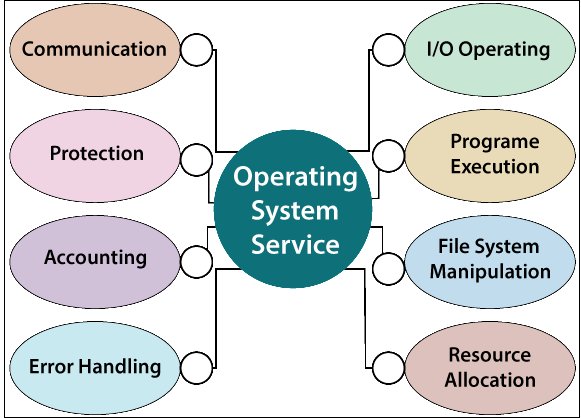Operating System Services
The Operating System provides various types of services:
- I/O operation
- Program execution
- File system manipulation
- Communication
- Error Handling
- Resource allocation
- Accounting
- Protection

1. I/O Operation: - To execute a program, needs I/O, which consists of a file, or I/O device. Due to the protection and effectiveness, users are not able to manage the I/O device, so the operating system helps the user to perform I/O operations such as read and write operations in a file. The Operating system offers the facility to access the I/O device when needed.
2. Program execution: - Operating System is responsible for loading a program into memory and then executing that program. Operating System helps us to manage different tasks from user programs to the system programs such as file server, name server, printer spooler, etc. Each of these tasks is sum-up as a process. A process may consist of complete execution context like data to manipulate, OS resources in use, registers, code to execute, etc.
The operating system performs the following tasks for program management:
- Executes the program.
- Load the program into memory.
- Operating system offers a procedure for process synchronization.
- Operating system offers a procedure for deadlock handling.
- Operating system offers a method for process communication.
- Manages the program’s execution.
3. File System Manipulation
A file is a collection of information. For long term storage computer stores, the file is placed on the disk, and disk is the secondary storage. For example - Magnetic disk, CD, DVD, Magnetic tape. Each storage media has different properties or capabilities such as capacity, speed, data access, and data transfer method.
For easy and effective usage, the File system is organized in the form of directories, and the directories contain files and other directions.
The operating system performs the following activities for File System Manipulation.
- It offers an interface so that we can easily create and delete files.
- It offers an interface to create and delete directories.
- It offers an interface so that we can create a backup of the file.
- With the help of the operating system, we can access the program for performing an operation on a file.
4. Communication
The Operating system offers the facility of communication. The Process requires information exchange with another process. For executing a process on the same computer or different computer systems, it communicates with the help of the operating system. Communication between the processes is done with the help of message passing and shared memory.
5. Error Handling
The Operating system provides the service of error handling. An error may arise anywhere, like in I/O devices, Memory, CPU, and in the user program. The Operating system takes appropriate action for each error to ensure consistency and correct computing.
6. Resource allocation
In a system, when multiple jobs are executing concurrently, then resource allocation must be needed for each job. Resources include main memory storage, file storage, CPU cycles, and I/O devices. The operating system handles every type of resource by using schedulers. With the help of CPU scheduling, the task of resource allocation can be performed.
7. Accounting
Accounting service of the operating system helps to keep track of the system usage means which users use the resources for how much time and what type of resources are used by the system.
8. Protection: - If the computer system has different users and permits the concurrent execution of the various processes, then it is must to protect the processes from one another’s activities.